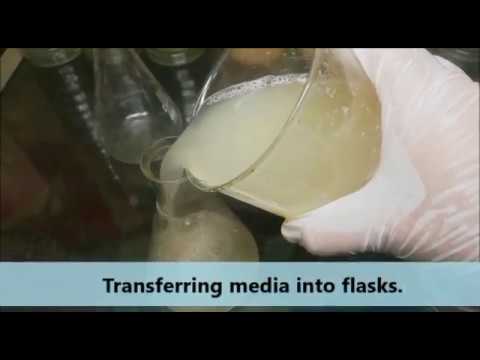
Practical Types of Media
Medium (media pl.) is the substance which provides nutrients for the growth of
microorganisms. The nutrient preparation on which culture is grown in the laboratory is
called culture medium Microbes require different nutrients for their growth. There is no
single medium which can support the growth of majority of microbes.
Thus, different types of media and environmental condition are to be used for a
given group of microbes. Many special purpose media are needed to facilitate,
recognition, enumeration and isolation of certain microbes.
Based on chemical composition, media can be classified into.
1) Natural 2) Semi-synthetic 3) Synthetic.
1. Natural medium: The exact chemical composition of this media isn't known properly. It
includes ingredients of natural origin like yeast extract, beef, milk, tomato juice, blood etc.
Sometimes this medium is also referred to as complex medium or non-synthetic medium
because medium is of complex type and contain various ingredients of unknown
chemical composition. This type of media is useful for cultivation of microbes whose
specific growth factor requirement is not known.
Eg. Carrot slices, potato plugs, twigs, milk, meat extract, peptone etc.
2. Semi-synthetic: The chemical composition of media is only partially known. Media,
which contains Agar, is semi-synthetic medium.
Eg. Potato Dextrose Agar medium, Nutrient Agar media.
3. Synthetic medium: The chemical composition of the medium is completely known.
These media are very useful in studying the physiology, metabolic nature and nutritional
requirements of microbes. Both autotrophs and heterotrophs can be grown in these
media.
Eg. Mineral glucose medium, Richard's solution, Raulins medium etc.
Based on consistency the media are of three types as 1) Liquid 2) Semisolid 3) Solid
medium
1. Liquid medium: Nutrient broth is the common liquid medium used in a microbiological
laboratory. Its drawback is that the morphology of bacterial colony cannot be studied. But
it supports a high microbial population.
2. Semi-solid medium: A semisolid medium is prepared with agar of concentration of 0.5%
and is useful in the cultivation of micro aerophilic or studying bacterial motility.
3. Solid medium: If agar is added to a nutrient broth, it becomes solid medium. It is used
for isolating microbes and to determine characteristics of colonies. It remains solid on
incubation and not destroyed by proteolytic bacteria. The addition of 15g of agar in 1 I of
liquid culture will produce a gel that liquefy at 95°C and solidifies at 40-45°C into gel.
Based on application or function, media can be classified as follows.
1. Selective media: Provide nutrients that enhance the growth and predominance of
particular microbe and don't enhance or may inhibit other types of organisms that may be
present. For instance, isolation of bacterium Neisseria gonorrhoeae from a clinical
specimen is facilitated by the use of media containing certain antibiotic. These antibiotics
don't affect pathogenic but inhibit the growth of contaminating bacteria.
2. Differential media: Certain reagents or supplements when incorporated into culture
media may allow differentiation of kinds of bacteria. If a mixture of bacteria is inoculated
on to blood agar media, some of bacteria destroy the RBC and others don't. Thus one
can distinguish between haemolytic and non- haemolytic bacteria on the same
medium.
3. Assay media: Media of prescribed composition are used for the assay of vitamins,
amino acids, antibiotics etc.
4. Enumeration media: Specific kinds of media are used for determining the bacterial
population in milk, water, soil and food etc.
5. Maintenance media: It is used for satisfactory maintenance of viability and
physiological characteristics of culture.


